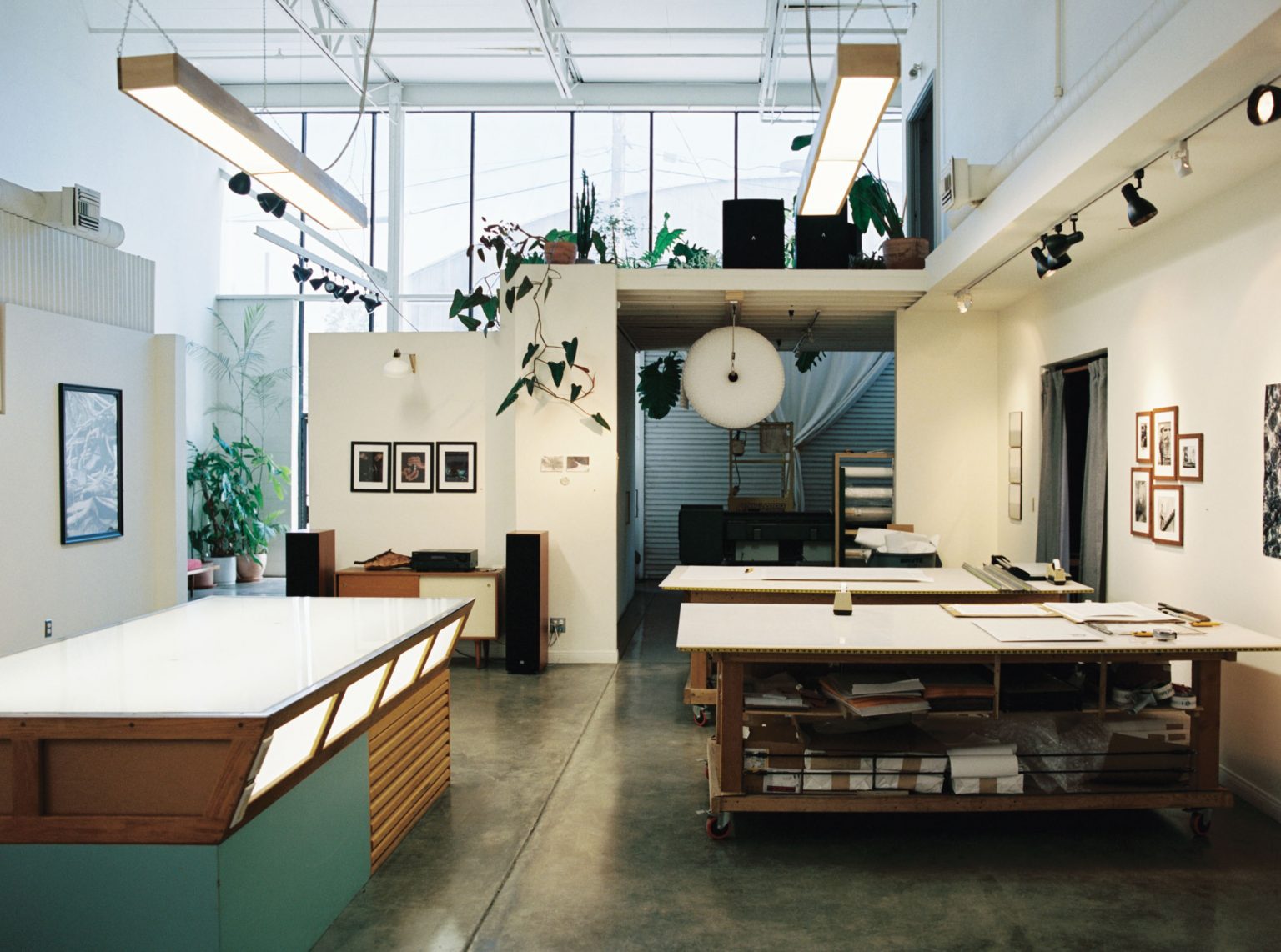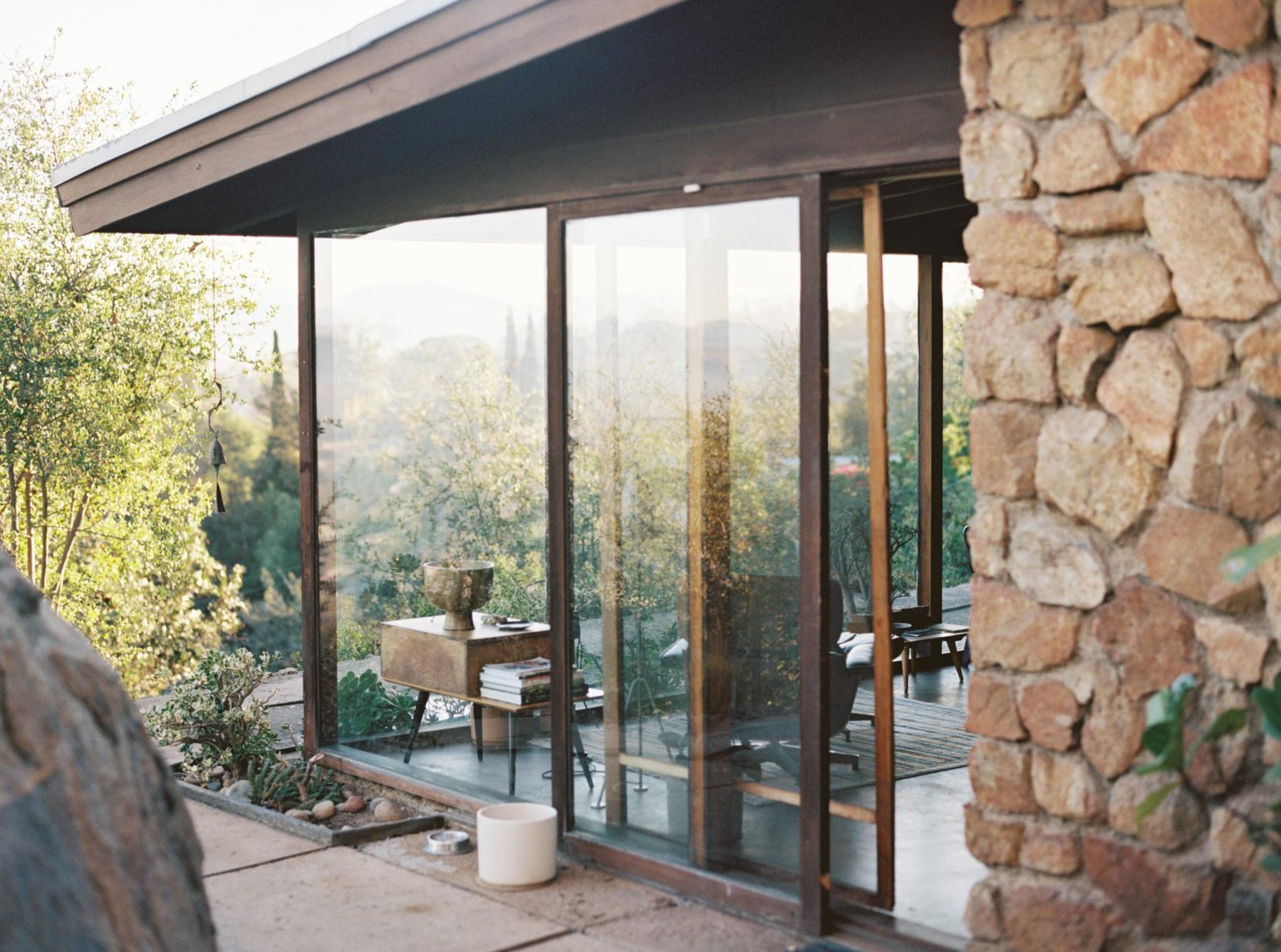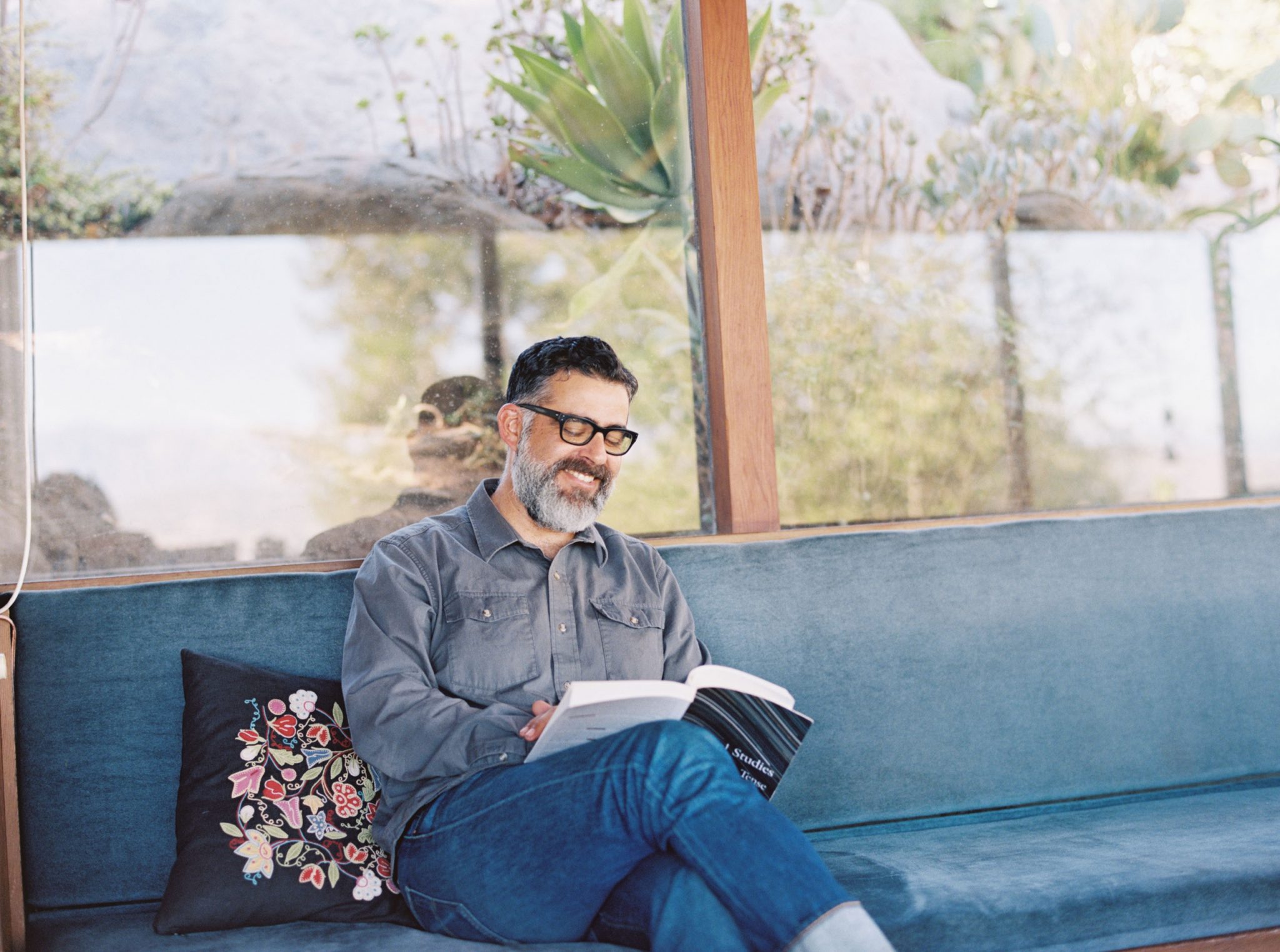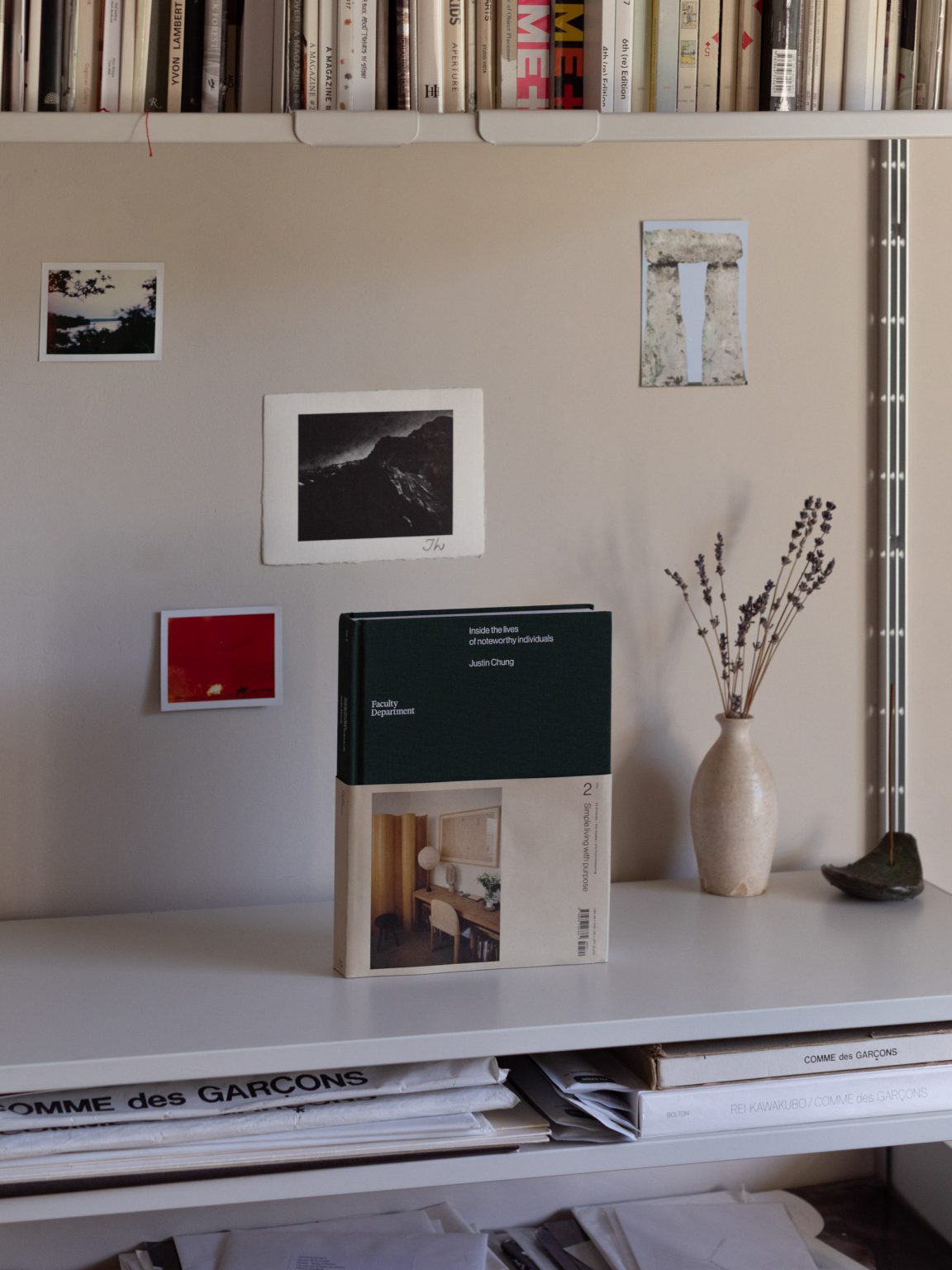In an alternate universe, Justin Chung would be known as Justin Chung M.D. His original path intended to lead him onto a path of medicine, but an internship would ultimately nudge his life onto a different course. His intrinsic approach towards problem solving and analysis is undoubtedly the marker of a great medical practitioner.
But in the creative world, this surgical approach towards creation embraces a structured and methodology that ensures its own set of outcomes and thinkings. After releasing his first installment of Faculty Department, a book dedicated to capturing the lives of creative people worldwide, Justin once again took on the labor of love to work on a second edition.

Chef Shoichiro Aiba, founder of the LIFE family of restaurants, at his home in Tokyo.
While books released in a serial format tend to follow a similar convention, Justin’s narrative approach towards creating forced him to rethink and reimagine how to connect and improve upon his original concept this second time around. Along this journey, he would also uncover what it is about his subjects he finds so fascinating, which is itself a supreme command of one’s live and distilling it down to purpose and simplicity.
We caught-up with Justin to hear about his journey as a photographer, the process of creating Faculty Department, and the most memorable elements of publishing the book.
You can order Faculty Department directly through Justin via his website. The book features intimate essays with a diverse range of subjects including Esteban del Río, University of San Diego; Shoichiro Aiba, LIFE Restaurant; Deborah Royer, Le Labo; Chris Gentile, Pilgrim Surf + Supply; Fanny Singer & Mariah Nielson, Permanent Collection; Rosa Park & Rich Stapleton, Cereal and many more.

Sanso, the Los Angeles retail studio of husband and wife, Chris McElrath and Yunice Kang.



“Further down the river is a fine art photo lab, Contact, where maestros and neophytes alike come together to use the last community darkroom in Los Angeles.”
Eugene Kan: How would you describe your relationship with photography after all these years and how does it influence your book concept, Faculty Department?
Justin Chung: Over the past 10 years, I’ve been pursuing commercial photography and editorial photography. I’ve been meeting all kinds of people on these jobs through traveling, like when I connected with you in Hong Kong. Photography is the tool for me to share these stories of personal connections I’ve made, and showcase it potentially in a way that’s not always commercially driven. Instead it’s more of a celebration of everyone’s journey of where they’re at.
I’m really curious about this process because growing up, I didn’t really know that many people that were pursuing this freelance lifestyle or art-based career. Now it’s the culture of people that I continue to surround myself with and I’m always so fascinated with how people make their living or structure their days. That’s why I’ve pursued this project so seriously because I’ve gotten to know these people over the years, and I’m so inspired by their lifestyles that I hope to share those experiences or memories and highlight a way of living.
Eugene: I remember the first time we met, you suprised me with a story of how you got your start. Most people know you as a talented photographer and the publisher of Faculty Department, but your past suggests you were on a different path. Paint us a picture of what it was like before photography.
Justin: I went to the University of San Diego and was doing pre-med. I was interested in healthcare and hospital culture around it alongside the achievements required to make it. But it really hit me when I took an internship at a hospital in Cambodia.
There, I realized pursuing medicine wasn’t necessarily for me, but I love the idea of seeing things on a bigger scale, beyond just one-to-one patient care. And it’s funny, it turns out that hospital in Cambodia, called Angkor Hospital for Children, was actually founded by a photographer named Kenro Izu who was a National Geographic photographer. I remember looking in the hallways and it was very photo-driven with its own photography wing.
“I’ve always loved photographs that had this realness to it, where somebody is caught off guard and it’s a candid moment. Those are the photos I personally enjoy the most and that I’d want to see. It’s obviously not that easy to achieve. So I’m always impressed when a photographer has this sense of ease throughout their work.”
There was a big exhibition with Steve McCurry, the famous Nat Geo photographer too. After that internship, I ended up switching gears and getting a Master’s degree in public health at UMass Amherst. But it really hit me though, I had this itch to kind of pursue this creative outlet like photography.
I had no idea how to even really use a camera and I didn’t have any technical or academic background. I never took any darkroom classes but it was something that I wanted to immerse myself into it. I started doing test shoots and, quickly beat myself up though because I wasn’t getting the results I wanted. I didn’t really think it was for me after a while.
Eugene: Why is that? What was preventing you from moving forward?
Justin: I had this vision of what I wanted to achieve and I wasn’t able to translate it, so it really ate me up. But luckily, the people that I met early on were super supportive and helped me come to terms that to advance, maybe I should consider moving to LA or New York to pursue it more seriously. I would have more success if I was immersing myself in an area that was more saturated with photography which meant leaving San Francisco. So I made the move to New York in 2011 and just went for it.
My girlfriend now wife, did a four months sublet in Brooklyn and we’re like, “let’s do this for a month and if it doesn’t work out, I’ll go back to the Bay area and crash at my parents house and pursue medical school.” Four months turned into a year, then two years… I got into a groove and I never left, and it took me eight years to finally relocate back West where I am now in Los Angeles, because we were expecting our kid at the time.

Fanny Singer is a writer, editor, and co-founder of the design brand, Permanent Collection.
Eugene: That’s a pretty big swing in terms of career changes, especially going from a non-traditional creative field, such as medicine to photography. What do you think it is within your personality that allowed you to make that switch? You mentioned that you had this insatiable desire to learn, all while beating yourself up along the way. What’s in like inside your mind?
Justin: Sure, maybe because I am self-taught and because I have a few years of experience with going to grad school and all that… I treat my photo assignments a little bit more textbook style. I do things like I’ve done research papers or presentations in the past. So, maybe that aspect has helped me pursue photography in the way I feel most comfortable working in.
Eugene: How has having a nontraditional and self-taught background allowed you to develop your own style?
Justin: How do I define my style? There are definitely photographers that really love. Before I even considered myself a photographer, I always loved Bruce Weber’s work that I would see in shopping malls and for Ralph (Lauren) and Abercrombie. I was always curious how he could showcase this grand lifestyle in a still photo. That to me was always a big source of inspiration.
I’ve always loved photographs that had this realness to it, where somebody is caught off guard and it’s a candid moment. Those are the photos I personally enjoy the most and that I’d want to see. It’s obviously not that easy to achieve. So I’m always impressed when a photographer has this sense of ease throughout their work. That’s one of the things that I try to emulate and embed in my work, a sense of casualness, realness, and intimacy.
Eugene: What was the lightbulb moment for you to put together Faculty Department?
Justin: Yeah, that’s a great question. I think honestly it’s one of those things where you get inspired after meeting all these makers whether they’re clothing designers, furniture makers, or painters. At the time when this book really kicked into high gear, I wanted to push myself and not just make it a web project. I really wanted to use this opportunity to explore and to put myself in the shoes of these creators and make something. It became a point of no return.
After shooting the first six to 10 people, I realized that it had to be a book and all things happened organically around that. In these random meetings with friends, I would bring up the book and a friend mentioned that they had printed a book in Iceland and somehow the producer was based in Brooklyn, just a few blocks from where I lived. That just facilitated the whole conversation and it was making it easy to move from one step to the next.

Architect Harry Gesner (also pictured in the title image at the top).

Outside the The Sandcastle, one of Harry’s many iconic homes.
Eugene: How are things now for the second release?
Justin: It’s been five years in the making and the circumstances are a little different. I have two kids now, and making a book, being out and shooting these kinds of projects isn’t that easy anymore. So I’ve been way more strategic with how I’ve kind of produced the stories and how I execute it. But this time around, it was a lot slower because, I was running into the trouble of finding what the purpose of this book was and I didn’t want it to be a bigger volume with a random mix of stories. I wanted it to have some sort of thread that connected the stories throughout.
Eugene: So the process itself changed a bit?
Justin: After the first book dropped. I started making a running list of people who I thought would be a great fit for the next book. And it was a slow process. It’d be one story and then, six months later, the next story. But, it kicked into higher gear after I went on a trip to Japan to photograph one of the stories in the book. Aiba was a chef that I met through the owner Tokuhiko Kise of TRUCK Furniture, who I featured in the first book. He’s a chef and he took me to his country home in Nasu where it’s full of nature. I spent the weekend with him and got to know his values, his approach to work, and how he takes time off to maintain a lifestyle with his kids. Visually it was stunning with Swedish cabin in the middle of the countryside of Japan.
It really hit me and opened my eyes to this way of living, specifically in a more simple casual way. What really hit me on that trip, was that he’s a chef and values his food so much, but at his cabin, there’s not even a dining table. You eat on the floor. There’s a coffee table where you can watch movies or read a book, but he wanted to strip away the formalities of his life during the week. I left that trip on my drive home with him, writing in my notebook, looking into themes that I came across. And I surmised, the book was about simple living with purpose.
From that point on, I really wanted to convey a mix of different lifestyles and creative paths, but convey this casualness by giving you a glimpse into the company, the culture of the day-to-day, and embedding a glimpse into this kind of simple lifestyle.
Eugene: This whole process has taken several years to complete. When you started, we weren’t even near to being in this world of peak social media. What does it mean to do something that is on your own timeline versus the timeline of digital immediacy and that’s not bound by those pressures?
Justin: For me it’s all ultimately down to the experience. For instance, a story, I can share that with you right now and just send it over to you. But I think for me, magazines or books hit me in a different way than it does on Instagram posts or any sort of social media media channel.
These people within the book mean so much to me and have shaped my life personally that to share these stories with you or anyone else had to be in a book format. It just presents it differently, it presents information in, in a way that I personally find inspiring and the best way I can show it.
“I really wanted to convey a mix of different lifestyles and creative paths, but convey this casualness by giving you a glimpse into the company, the culture of the day-to-day, and embedding a glimpse into this kind of simple lifestyle.”
Eugene: What sort of personal growth have you derived from doing this project? Is there anything you learned about yourself or like even something that contributed to your process? I find these types of projects different as an editorial or personal project versus a commercial shoot.
Justin: It was actually quite challenging for me because in this project there’s no shot lists or assistance. There’s no art director. It’s literally just me and the subject and we’re winging it. And the whole project was shot on film so that we can focus on being in the moment.
It really challenged me to work at a different level and I think it helped me gain some insight and help me learn how to work in a different way. Even after the very last story was shot, it was still challenging. It wasn’t as though it got easier after doing four or five of them. It was nonstop, figuring it out and that level of stress was actually pretty amazing because it really helped keep me on edge.
Eugene: What was your most memorable moment looking back?
Justin: This one gives me goosebumps thinking about it. Since moving back to the West coast, I’ve reconnected with my college advisor, Esteban del Rio, who was my advisor in San Diego. He wrote my letter of recommendation to graduate school and we both went to the same graduate school at UMass Amherst. He’s been following my work from the beginning, even before the transition to photography and then moving to New York to pursue photography.
When moving back to California, he was a consultant of sorts to help me conceptualize what Faculty Department really is. What’s been really memorable and inspiring for me was that I was able to reconnect with him and, and actually photograph him for the book. And, he opens up the book for the readers in the first chapter.
Eugene: That’s amazing how it all came full circle. Do you have a particular takeaway that you want people to have, beyond the fact that these are people that are doing their own thing. Is there a message you want people to walk away with?
Justin: Throughout, my photography has been a path. These people have really shaped and helped influence my journey over the years. And I just hope that people take something, whether small or large away from it. I hope someone’s creative endeavors strikes helps inspire their own creative journeys.

Outside Professor Esteban del Río‘s home in San Diego. He was Justin’s advisor there and helped to conceptualize Faculty Department.


Eugene Kan: A lot of the people you profile are founders and people working independently. What’s that draw for you?
Justin Chung: It’s a tough path to pursue. You and I both are working on that route. I feel like the only way I have been able to dive into it and survive is surround myself with these similar kinds of people. We learn and get advice from each other. Although we’re all on different kinds of journeys and with different occupations, I’m trying to bring in the values and the philosophies of say Aiba’s approach to cooking, into my own photography. I’m hoping he sees my photography and appreciates the style similar to how he might appreciate Italian food, how it’s cooked. It’s about creating this synergy.
Eugene Kan: My last question, what did you think it’d be like to publish a book and what has been the reality?
Justin Chung: Oh man, it’s so difficult. That was the one biggest takeaway. It was layers on layers of different tasks. I thought it would get easier but it only gets harder. It’s making the edits to the photography then working on the layout, then the writing, working with the printer itself, and ensuring the files are processed properly. Although however difficult it may be, I feel like it’s been beyond rewarding to just be a part of the whole process and learn how something is done from the very beginning to the very end. It has been really beyond anything else I’ve experienced, seeing it all done. It’s the most fulfilling project to witness and see. But it also didn’t give me the feeling of, ‘okay cool, now let’s work on the next one.” More like time to take a break.
“Photography is the tool for me to share these stories of personal connections I’ve made, and showcase it potentially in a way that’s not always commercially driven. Instead it’s more of a celebration of everyone’s journey of where they’re at.”

A copy of Faculty Department, Volume 2 at Justin’s home in Los Angeles.





















